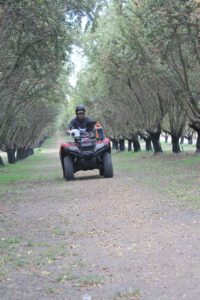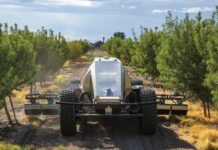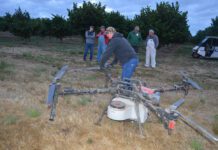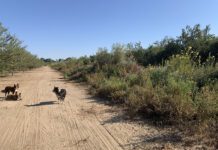Listen to the audio version of this article. (Generated by A.I.)
Can the traditional orchard care philosophy of “boots on the ground” be replaced by remote monitoring in tree nut orchards?
Private companies and UC are both testing the waters with remote-sensing systems that can be used for insect pest monitoring and collecting data on overall tree health and productivity.
Charlie Wu with Orchard Robotics said their company is taking a new direction in precision orchard monitoring, scaling up in size and sending accurate, detailed and specific information to growers including nut counts, color, yield estimates, disease detection, bloom monitoring and tree growth. In general, he said it means the difference between seeing a very small, usually imprecise sample size of data collected by a human versus being able to see every tree throughout the orchard and tell if or when there are issues and exactly where they are located. In addition to gathering specific data provided on a per-tree basis on a large scale, Wu said growers receive georeferenced information to see trends across an entire block or ranch. The information would allow for management decisions on a per-tree basis.

Instead of a human observation, Orchard Robotics has developed an artificial intelligence (AI)-powered camera system that mounts onto any vehicle (ATV, tractor, four-wheeler, etc.). The camera system takes more than 100 photos per second as the vehicle is driven down the rows of an orchard, scanning every tree they are driven past in detail. State-of-the-art AI models onboard each camera provide the information needed with image analysis. A GPS system precisely identifies the location where each tree was seen, and the information is then relayed to growers. Orchard Robotics has developed a full software platform where this data can be easily viewed, used and acted on by a grower the very next day following a scan.
Orchard Robotics’ technology uses AI and computer vision to count buds, blossoms and nuts on trees. It also provides data on bloom density and progression, yield estimates, nut color, disease detection, tree trunks, tree canopy vigor, canopy color and precise tree inventory and mapping. The company also has a dedicated scan quality assurance team that reviews each scan to ensure the results are accurate and detailed.
“The system is able to pick up the same information a human eye can pick up if they were to walk all the rows, except it is always accurate, consistent and detailed,” Wu said.
Compared with drone-supplied images from overhead, Wu said the system provides more detail from the ground since it can see more of the tree at a much closer distance from ground level.

Testing Underway
Wu said the system is deployed commercially at scale with some of the largest apple and grape growers in the U.S., along with work in blueberries, cherries, strawberries and citrus, and is now being tested in pistachio and almond orchards. He said Orchard Robotics is expected to make the system widely available to tree nut growers in 2026. In the previous crops tested, Wu said they have been able to reliably and accurately detect disease and water issues that exhibit symptoms on the tree, leaves and canopy itself with their AI models.
Once the models are trained for specific things in the orchard that almond and pistachio growers look for, Wu said they expect to deliver similar results.
Wu said if a grower asked 10 field techs to scout 1,000 acres for tree health, disease detection, pest infestation and crop yield, they would each come up with slightly different results. The camera provides accuracy and consistency across the orchard, and the system will perform the same no matter if there are one or 10 cameras in use at the same time across a ranch.
In an Oakdale-area almond orchard in August, technicians Adrian Maman and Chris Avila set up the camera system on a four-wheeler for a data collection test. A wireless connection to a tablet easily controls the camera and sets up the scan. This test was specifically to gather trunk data in an older orchard of a pollinator variety prior to harvest. Maman noted that with the wider row spacing and larger trees, the cameras would be adjusted.
While the system can scan at any speed up to 12 mph, Maman said he maintains a speed of 8 mph, allowing him to cover every row and every tree in about 260 acres in a day. The number of rows driven is done at the grower’s request.

UC Effort
A UC effort in remote monitoring is aimed at pest detection in fruit and tree nut orchards. Instead of driving to orchard locations to check sticky traps for insect activity, UCCE Farm Advisor Santosh Bhandari in Tulare County has developed a prototype device that can be used with the traditional sticky traps for pest monitoring. The device can also log temperature and humidity data. The device is mounted in front of sticky traps and programmed to take images of the trap at specified intervals. The data can be transferred remotely to the cloud for access.
Bhandari, in a UC ANR blog post, said the device is currently semi-autonomous and can be used for remote pest monitoring. The device can be integrated with machine learning in the future. The AI technology can be integrated into the system to quantify the number of pests captured in the trap, eliminating the need for PCAs to manually count insects in the images. The device can be adjusted to take and send data over a period of 8 to 12 hours.
Delivers Agronomic Data
“Remote monitoring can be a tool in a precision system,” Sebastian Saa, Almond Board of California’s senior manager of research, said. “It can help us understand variability and analytics such as yield. But how that tool is used is important. We need it to also deliver actionable insights.”
Saa noted the use of precision management tools in almond production and the potential for reducing inputs, one of the board’s goals. Remote monitoring tools can deliver many key agronomic data on an orchard, but the value lies in clear direction to address issues.

Cecilia Parsons | Associate Editor
Cecilia Parsons has lived in the Central Valley community of Ducor since 1976, covering agriculture for numerous agricultural publications over the years. She has found and nurtured many wonderful and helpful contacts in the ag community, including the UCCE advisors, allowing for news coverage that focuses on the basics of food production.
She is always on the search for new ag topics that can help growers and processors in the San Joaquin Valley improve their bottom line.
In her free time, Cecilia rides her horse, Holly in ranch versatility shows and raises registered Shetland sheep which she exhibits at county and state fairs during the summer.
















